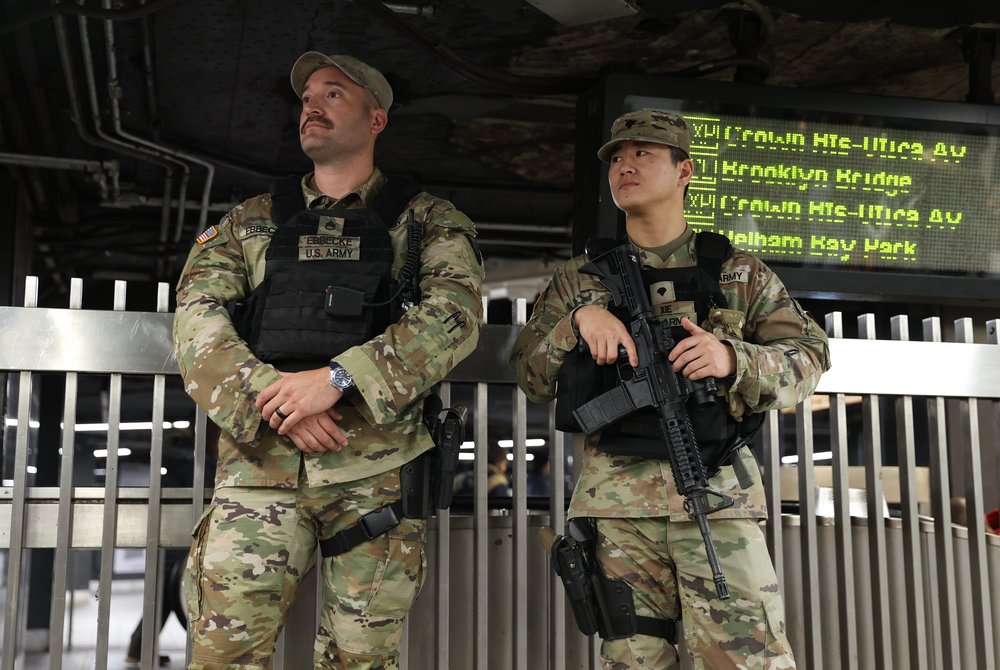National Guard presence in NYC subway echoes 9/11 aftermath and 1965 blackout
March 8, 2024, 4:14 p.m.
"Have we lost control that bad?" one criminal justice expert wonders.

Gov. Kathy Hochul’s decision this week to address subway safety by sending 750 National Guard members into New York City's transit system has little precedent in state history.
The last time the military was seen in the subway system in large numbers was the aftermath of 9/11, when more than 2,700 people were killed in the collapse of the Twin Towers. Before that, the National Guard helped rescue commuters trapped in subways during a blackout in November 1965.
This year, three people on the subway were murdered and a conductor was slashed in the neck.
Hochul said the National Guard presence would provide a “psychological” effect to deter crime and comfort riders, in part by assisting other law enforcement with bag checks.
But Felipe Rodriguez, a professor at John Jay College of Criminal Justice, said that isn’t the purpose of the National Guard.
“They're basically trained to keep a civil disturbance down," he said. "But policing is totally different. I think we're going to do more harm than good at this point.”
National Guard members get military-style training, while NYPD officers are better trained to deal with daily interactions with the public. Additionally, the National Guard is not authorized to make arrests.
NYPD Chief of Patrol John Chell apparently agreed. After Hochul's announcement, he wrote on the social media platform X that the city's transit system was “not a war zone.”
NYPD data shows major felonies in the transit system are down 13% in the last 28 days compared to the same period last year. Chell argued the statistics showed that a surge of 1,000 police officers into the subway ordered by Mayor Eric Adams was working. Still, major felonies in transit are up 13% year to date compared to 2023.
Hochul’s office noted National Guard members have been stationed at major transit hubs in the city, including Penn Station and Grand Central, as part of a post-9/11 security initiative dubbed Operation Empire Shield. But those numbers of uniformed members do not compare to the 750 members the governor dispatched this week.
Rodriguez said the subways were not dangerous enough to warrant sending in the military.
“Have we lost control that bad? Because I think that's the message that we're kind of sending: Things have gotten so bad that we're at a point of a national crisis or a statewide emergency,” he said.
Some commuters who spoke to Gothamist on Thursday didn’t see the National Guard as a comforting presence.
“It terrifies me that these men have these automatic gun machines,” Bushwick resident Daniela Blini said at Grand Central Terminal. “God forbid if something go[es] crazy here and they start shooting. I might be one of the ones they kill — to keep the society safe!”
Rodriguez, who worked in law enforcement for 31 years, also criticized Adams’ surge of police into the subway system. He called it “smoke and mirrors.”
“They're going to get burned out,” Rodriguez said. “When you burn out cops, we make bad decisions.”
Public Advocate Jumaane Williams blasted both Hochul’s and Adams' approaches.
“How many surges of law enforcement into the subway will satisfy the political desire of city and state leaders to address riders’ fears being fanned by those same leaders?” he wrote in a statement this week. “New Yorkers deserve to be and feel safe on our subway. So instead of posturing to look ‘tough on crime,’ stuck in the same conversations, let’s get serious about safety, and what it actually involves.”
Williams, though, didn’t offer any suggestions on how to improve safety and didn’t respond to a request for comment.
‘It terrifies me’: NYC subway riders react to Gov. Hochul’s National Guard deployment NYPD will ramp up subway bag checks as Gov. Hochul pledges to deploy state personnel Hochul deploys National Guard, state police to do mandatory bag checks in NYC subway 3 murders on NYC subways this year come amid costly NYPD surge, vast surveillance